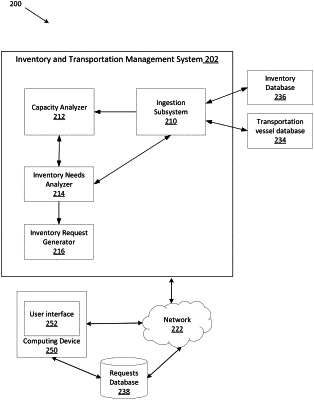| CPC G06Q 10/087 (2013.01) [G06Q 10/0835 (2013.01); G06Q 30/0635 (2013.01)] | 18 Claims |

|
1. A method of managing inventory and transportation vessels within an enterprise system, the method comprising:
receiving, at a software tool implemented on an inventory and transportation management computing system comprising at least one processor, inputs related to current inventory levels for at least one inventory item selected from a plurality of inventory items, and an optimal inventory balance for the at least one inventory item for a location, the location selected from a plurality of retail locations, a receiving center, and a flow center;
receiving, at the software tool, inputs related to a capacity of at least one transportation vessel selected from a plurality of transportation vessels;
determining, by a capacity analyzer of the inventory and transportation management computing system, individually for each transportation vessel, a capacity constraint, the capacity constraint comprising a minimum amount of the at least one inventory item and a maximum amount of the at least one inventory item that can be transported on the transportation vessel;
dynamically determining, by an inventory needs analyzer of the inventory and transportation management computing system, an inventory need for a predetermined initial future time period for each of the at least one inventory items, the inventory need being the difference between the current inventory level and the optimal inventory balance, wherein the capacity analyzer and the inventory needs analyzer are executed at least partially in parallel by the at least one processor;
automatically generating an inventory request by:
determining an inventory amount to be ordered for the at least one item based on the inventory need;
determining a number of transportation vessels of the at least one transportation vessel needed to transfer the inventory item to the location;
assigning the at least one inventory item to the at least one transportation vessel, wherein assigning the at least one inventory item to the at least on transportation vessel includes determining whether utilization of the at least one transportation vessel is within the capacity constraint and rounding up or rounding down the inventory amount to be ordered for the at least one item until the utilization of the at least one transportation vessel is within the constraint, and wherein rounding up or rounding down the inventory amount to be ordered for the at least one item is initially based on inventory need determined at a first predetermined periodic basis and fine-tuned with an inventory need determined at a second predetermined periodic basis having greater granularity than the first predetermined periodic basis;
determining packing instructions for the at least one transportation vessel that maximizes the utilization of the at least one transportation vessel; and
generating the inventory request including the rounded up or rounded down order amount for the at least one inventory items and the packing instructions for the at least one transportation vessel;
automatically communicating the inventory request, wherein the inventory request includes a purchase order including the rounded up or rounded down order amount for the at least one inventory item to order and a packing instruction for the transportation vessel; and
generating and providing a user interface including the order read request and a diagram depicting the packing instructions for the at least one transportation vessel.
|